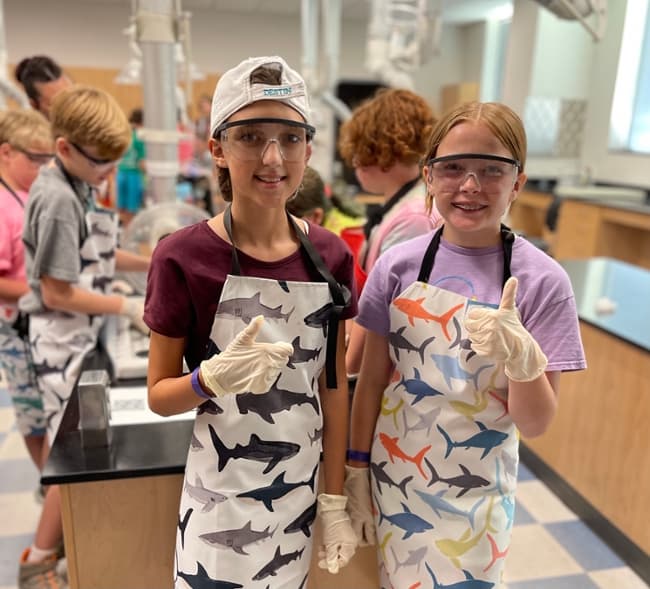Sea Campers Take a Bite Out of Shark Week
August 2, 2022
Tweet
By Andréa Bolt, Social Media & Communications Manager
The aprons are tied, goggles donned, and gloves are snapped on; it’s time to dissect sharks!
Summer campers, ages 10 to 12, have been learning all about sharks and their stingray cousins in their week-long “Sharks & More” SeaCamp at the Texas A&M University at Galveston Campus.
With nearly 20 different camp programs and formats to choose from—including day camps, overnight, those for younger children, up to teenagers aged 18—SeaCamp has been inspiring aspiring young marine biologists since 1986.
SeaCamp Program Coordinator Lorena Elser ‘14 says dissection day is always popular during the shark-centric camp.

“We really allow them to get hands-on in the marine environment, to fully immerse themselves in it,” she says of the vessel trips, fishing expeditions, marshland exploration, and more that campers get to experience.
In the lab, two groups of campers gather around trays containing the carcasses of two spiny dogfish sharks. These bottom-dwelling sharks live along the Atlantic coast, often hunting smaller fish in packs, hence the dog-like comparison fishers used to name them. The compact species range from around 40-50 inches in length.
One camper remarks on the dogfish’s long, pointy snout. Another wants to know if they can touch its eye. SeaCamp Instructor Stanzie Sesher ‘13 calls for attention to explain the various parts of the shark and how to begin dissection.
Amid squeals of delight and a few potentially over-dramatized gasps, campers cut into their respective sharks. Sesher directs them to dissect along the animal’s midline, stopping them to inspect the dorsal fin, liver, heart, reproductive organs, and eyes.
“This is the perfect place to grow their passion for the ocean. Learn, challenge, inspire, explore...we want them, we encourage them to be curious,” Elser says.
Eleven-year-old Hunter from Pearland takes that curiosity to heart. As he turns the shark eye between his fingers, holding it up to the bright lab light, Sesher explains the lens is harder than a human eye. Unlike in humans, she says, sharks have muscles that move the lens part of the eye forward or backward to focus light, giving sharks great visual acuity.
The hands-on lesson is one that multiple campers said they can’t wait to get home to tell their parents about.
“Once I looked into the eyes of a dolphin, that was it for me,” Elser said of her lifelong love of the ocean. Perhaps this week will have laid the same foundation for the shark campers.
“Can I take the eye home with me? Please!” one camper begs a counselor.
“No, we’ve got to leave everything here,” she tells the camper, “But I’m glad you enjoyed it!”
Thinking quickly, he takes out a cell phone and snaps a photo.
“So cool,” he whispers, staring at the photo as the campers file out of the lab.
###
Media contact:Social Media & Communications Manager
a_bolt@tamug.edu
More:
Read more about Arts & Humanities
Read more about Science & Technology
Read more about Marine Biology
Read more about Marine Sciences